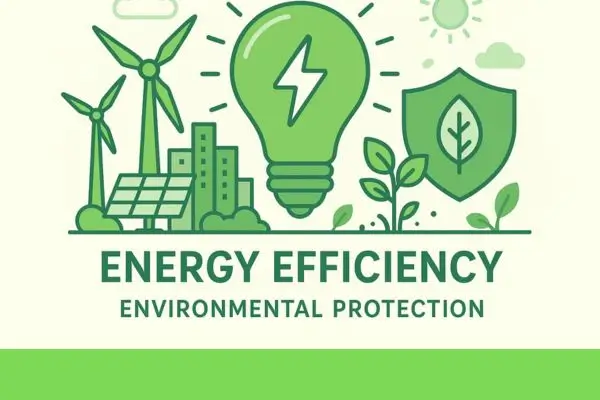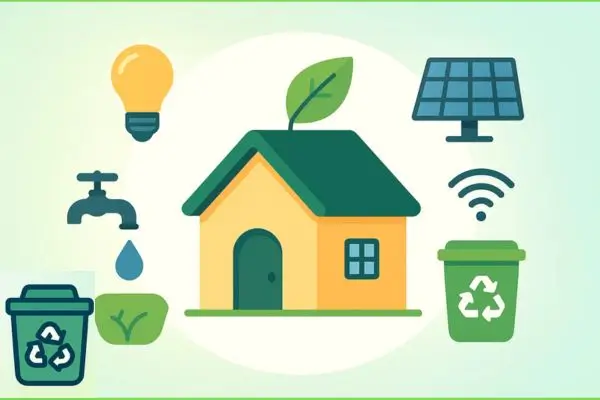Environmental safety isn’t just about big policies—it’s also about the small choices we make every day. From saving energy to reducing waste. In recent years, the urgency to address climate change and environmental degradation has become increasingly apparent. As individuals, we have a crucial role to play in reducing our carbon footprint and promoting sustainability. One of the most impactful ways to do this is by making our homes more eco-friendly.
Table of Content
Table of Contents
Intro: Environmental Safety
In Europe, where environmental consciousness is high and regulations are stringent, there are numerous innovative ideas and practices that can be adopted to protect our planet while creating comfortable and efficient living spaces.
This guide at HS Tech, you can explores a variety of European home eco protection ideas, covering energy efficiency, water conservation, sustainable building materials, renewable energy sources, waste reduction strategies, and improving indoor air quality.
By implementing these ideas, homeowners can reduce their environmental impact, save money on utility bills, and create healthier living environments. Let’s dive into the world of eco-friendly home solutions and discover how we can all contribute to a greener future.
1. Energy Efficiency
Energy efficiency is a cornerstone of eco-friendly homes. By reducing energy consumption, we can lower greenhouse gas emissions and save on utility bills. Here are some key strategies for improving energy efficiency in European homes:
- Smart Thermostats: These WiFi-enabled devices allow homeowners to control heating and cooling systems remotely and learn usage patterns to optimize energy use. In the UK, smart thermostats have helped homes save up to 16.5% on energy use (GreenMatch).
- Energy-Efficient Lighting: Switching to LED bulbs can significantly reduce energy consumption. LEDs last up to 12 times longer than traditional bulbs and are 80-90% more energy-efficient, reducing carbon emissions by up to 40kg annually per bulb.
- Insulation and Draught Proofing: Proper insulation and sealing gaps can prevent heat loss, which accounts for up to 40% of heating energy in homes. This includes double or triple-glazed windows, cavity wall insulation, and loft insulation, which can save up to 25% of heating energy lost through the roof.
- Energy-Efficient Appliances: Appliances with high energy efficiency ratings (A-rated or higher) consume less energy. For example, an Energy Star washer uses 35-50% less water and 50% less energy per load compared to traditional washers.
- Switch Heating Sources: Upgrading to modern A-rated boilers or heat pumps can improve efficiency. Heat pumps can be up to 600% efficient, and the UK’s Boiler Upgrade Scheme offers £5,000 grants for air source heat pumps.
- Boiler Servicing: Annual maintenance ensures boilers operate efficiently, preventing increased fuel consumption as they age.
| Energy Efficiency Strategy | Potential Savings |
| Smart Thermostats | 16.5% energy use |
| LED Lighting | 40kg CO2 per bulb/year |
| Insulation | 40% heating energy |
| Energy Star Washer | 35-50% water/energy |
| Heat Pumps | Up to 600% efficiency |

Water Conservation
Water is a precious resource, and conserving it is essential for sustainability. The average household uses 130,000 gallons of water per year, but simple measures can save up to 44,000 gallons annually (Eartheasy). Here are effective water conservation methods for European homes:
- Low-Flow Fixtures: Installing low-flow showerheads, faucets, and toilets can reduce water usage. A low-flow showerhead uses less than 2.5 gallons per minute compared to 5 gallons for traditional models. Dual-flush toilets save up to 70% water per flush.
- Fix Leaks: A small drip can waste 20 gallons of water per day. Regularly check faucets, pipes, and toilets for leaks using a food coloring test in the toilet tank.
- Efficient Appliance Use: Running full loads in dishwashers and washing machines with eco-settings can save water. Modern dishwashers use half as much water as hand washing, saving up to 5,000 gallons per year.
- Recycle Water: Use greywater from showers or dishwashing for watering plants or flushing toilets.
- Rainwater Harvesting: Collecting rainwater for gardening or other non-potable uses reduces reliance on municipal water supplies, especially in water-scarce regions.
| Water Conservation Method | Potential Savings |
| Low-Flow Showerhead | 5-10 gal/min |
| Dual-Flush Toilet | 15,000 gal/year/family |
| Dishwasher vs. Hand Washing | 5,000 gal/year |
| Leak Repair | 20 gal/day per drip |
2. Sustainable Building Materials
Choosing sustainable building materials is crucial for reducing the environmental impact of construction and renovation. Buildings account for over 30% of the EU’s environmental footprint, with one-third of material consumption going to construction (EEA). Here are popular sustainable materials used in European homes:
- Bamboo: A fast-growing renewable resource, bamboo is ideal for flooring and furniture, absorbing more CO2 than trees (BigRentz).
- Recycled Materials: Using recycled plastic, glass, and steel reduces landfill waste and the need for new raw materials.
- Cork: Harvested from cork oak trees without harming them, cork is renewable, recyclable, and provides excellent insulation.
- Adobe Brick: Made from clay and straw, adobe bricks are natural insulators with a low carbon footprint, popular in some European regions.
- Straw Bales: Used for insulation, straw bales are biodegradable and have low emissions.
- Reclaimed Wood: Sourcing wood from old buildings or furniture reduces deforestation and preserves lumber integrity.
| Material | Benefits |
| Bamboo | Fast-growing, high CO2 absorption |
| Recycled Plastic | Reduces landfill waste |
| Cork | Renewable, mold-resistant, insulating |
| Adobe Brick | Natural insulation, low CO2 production |
| Straw Bales | Biodegradable, low emissions |
| Reclaimed Wood | Reduces deforestation |
3. Renewable Energy Sources

Renewable energy is key to reducing reliance on fossil fuels and lowering greenhouse gas emissions. In 2023, renewable energy sources accounted for 24.5% of the EU’s final energy use, with a target of 42.5% by 2030 (EEA). Common renewable energy sources for European homes include:
- Solar Power: Photovoltaic panels convert sunlight into electricity. The REPowerEU Plan aims to double solar PV capacity to 600 GW by 2030 (European Parliament).
- Wind Power: Small wind turbines are suitable for homes in windy locations, with the EU targeting 60 GW of offshore wind by 2030.
- Biomass: Wood pellets or other biomass are used for heating, particularly in rural areas. Countries like Finland and Portugal rely heavily on biomass (Euronews).
Many European countries offer incentives, such as grants and tax credits, to support renewable energy adoption.
| Renewable Source | EU Target/Status | Source |
| Solar Power | 600 GW by 2030 | European Parliament |
| Offshore Wind | 60 GW by 2030 | European Parliament |
| Renewable Energy | 42.5% by 2030 (24.5% in 2023) | EEA |
4. Waste Reduction
Reducing waste is essential for a sustainable lifestyle. The EU generates massive amounts of waste, and not enough is recycled, prompting efforts to create a circular economy (EEA). Here are strategies for waste reduction in European homes:
- Composting: Turn food scraps and yard waste into nutrient-rich compost for gardens, reducing landfill waste.
- Recycling: Properly sort and recycle paper, plastic, glass, and metal. Countries like Slovenia achieve high recycling rates (67.1% in 2019) through effective collection systems (Ecostar).
- Reduce Food Waste: Plan meals, store food properly, and use leftovers to minimize waste. Apps like TooGoodToGo can help save food from being discarded (One Tree Planted).
- Reuse and Repair: Fix broken items and repurpose old materials, such as turning old clothes into reusable bags.
- Donate or Sell: Give unwanted items a second life by donating or selling them.
Participating in initiatives like the European Week for Waste Reduction (EWWR) can further promote waste prevention (EWWR).
| Waste Reduction Strategy | Impact |
| Composting | Reduces landfill waste |
| Recycling (Slovenia) | 67.1% recycling rate in 2019 |
| Food Waste Reduction | Saves food from landfills |
5. Improving Indoor Air Quality
Good indoor air quality is vital for health, as Europeans spend 90% of their time indoors, where pollutant levels can be two to five times higher than outdoors (EVIA). Here are ways to improve indoor air quality in European homes:
- Ventilation: Regularly ventilate homes, especially when cooking or using cleaning products, to reduce pollutant buildup.
- Air Purifiers: Use HEPA filter air purifiers to remove dust, pollen, and other pollutants. We can also use a best way that is about the use of some special kind of plants, these plants acts as a air purifiers. this a best natural and low cost method.
- Low-VOC Products: Choose paints, furnishings, and cleaning products with low volatile organic compounds to minimize harmful emissions.
- Control Humidity: Keep humidity levels between 30-50% to prevent mold growth.
- Ban Smoking Indoors: Smoking indoors significantly degrades air quality, contributing to respiratory issues.
European standards for indoor air quality encourage the use of certified products to ensure healthier living environments. We can also use a best way that is about the use of some special kind of plants, these plants acts as a air purifiers. this a best natural and low cost method.
| Indoor Air Quality Strategy | Benefit |
| Ventilation | Reduces pollutant buildup |
| HEPA Air Purifiers | Removes dust, pollen, allergens |
| Low-VOC Products | Minimizes harmful emissions |
Case Studies and EU Policies
- Hazel Tree House (UK): Designed by GreenTrace Architects, this eco-home uses natural materials like timber and cellulose insulation, achieving low embodied carbon and high energy efficiency.
- EU Policies: The European Green Deal and Renewable Energy Directive set ambitious targets, such as 42.5% renewable energy by 2030. The Waste Framework Directive mandates separate textile collection by 2025 to promote recycling.
Conclusion
Creating an eco-friendly home in Europe involves a combination of energy efficiency, water conservation, sustainable materials, renewable energy, waste reduction, and good indoor air quality. These practices align with the EU’s commitment to sustainability and climate neutrality by 2050.
By adopting these strategies, homeowners can significantly reduce their environmental impact, save money, and create healthier living spaces. With the support of government incentives and policies, transitioning to a more sustainable lifestyle is both feasible and beneficial for the planet and future generations.
Learn about Yatao Camera
Pingback: Electric Vehicles Demystified: The Ultimate easy Guide
Pingback: What is Supercomputer? Machines That Power Our Future, 5 powerful Features
Pingback: Virtual AI Influencer Makes a great Amount of $12,300 Per Month: How You can make?
Pingback: 10 Best Free AI Text Generators 2025 for writers